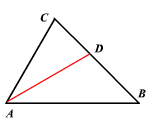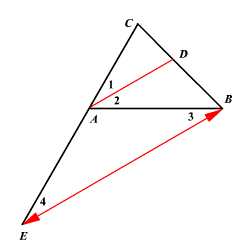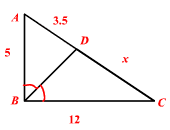Theorems can be very useful to us in the world of mathematics. A theorem is something that we know is true -- something that can be proven. In simpler terms, theorems are tricks that we can use to solve all kinds of math problems. One such theorem is the angle bisector theorem. Let's find out how it works:
Before we get into the angle bisector theorem, we need to review an important term:
So what exactly is the angle bisector theorem? The theorem states that:
Remember that if two things are proportionate, it means that they have equivalent ratios or fractions. For example, 1:2 and 5:10 are equivalent.
For example, if an angle bisector divides the opposite side into two segments that are 5 cm and 3 cm, this would result in a ratio of 5:3. This would also mean that the other two sides of the triangle must be proportionate to this ratio -- perhaps 10:6.
Note that different textbooks may use slightly different definitions when referring to the angle bisector theorem, but the following definition is the most common.
As always, it helps to visualize this theorem in action in order to fully understand it:

As we can see, the angle P has been divided by an angle bisector. This bisector continues and intersects with line RQ at point L.
If we were to write the angle bisector theorem in a formula based on the above diagram, we would get something like this:
If line PL bisects ∠RPQ, then
As you might recall, all theorems can be proven. This is how we know we can rely on them. So can we prove that the angle bisector theorem is correct? Let's try:

Based on the above triangle, we can safely say that:
But can we prove it?
Let's start by drawing a new line, creating an entirely new triangle underneath the first triangle:

Why did we do this? As we can see, there are now two parallel lines: BE and AD.
This parallelism allows us to apply the side-splitter theorem. This theorem states that:
We also know that angles 1 and 4 are corresponding, which means that they must be congruent. In other words, they have the same angle measure.
Based on the fact that AD is the angle bisector of , we also know that is congruent to .
Now we can apply the alternate interior angle theorem, which states that is congruent to .
Finally, we apply the transitive property, which states that is congruent to .
What does this all mean? We have just established that is an isosceles triangle with two equal sides: AE and AB.
Now we can replace AE with AB and solve our previous equation:
Therefore, the angle bisector theorem is proven true.
Consider the following triangle:

Can we use this information to find the value of x?
Let's start with our formula for the angle bisector theorem:
Now let's plug in our values:
With a little cross-multiplication, we get:
Common Core: High School - Geometry Flashcards
Common Core: High School - Geometry Diagnostic Tests
Advanced Geometry Diagnostic Tests
Aside from the angle bisector theorem, there are many others to keep track of. This isn't always easy for the average student, and a tutor can help them memorize theorems with a number of helpful tips and tricks. They can also personalize their methods based on your student's learning style. For example, visual learners can memorize theorems using flashcards. Tutoring can be helpful for students of all ability levels, so let Varsity Tutors pair your student with an appropriate tutor today.
d:T2f97,Theorems can be very useful to us in the world of mathematics. A theorem is something that we know is true -- something that can be proven. In simpler terms, theorems are tricks that we can use to solve all kinds of math problems. One such theorem is the angle bisector theorem. Let's find out how it works:
Before we get into the angle bisector theorem, we need to review an important term:
So what exactly is the angle bisector theorem? The theorem states that:
Remember that if two things are proportionate, it means that they have equivalent ratios or fractions. For example, 1:2 and 5:10 are equivalent.
For example, if an angle bisector divides the opposite side into two segments that are 5 cm and 3 cm, this would result in a ratio of 5:3. This would also mean that the other two sides of the triangle must be proportionate to this ratio -- perhaps 10:6.
Note that different textbooks may use slightly different definitions when referring to the angle bisector theorem, but the following definition is the most common.
As always, it helps to visualize this theorem in action in order to fully understand it:

As we can see, the angle P has been divided by an angle bisector. This bisector continues and intersects with line RQ at point L.
If we were to write the angle bisector theorem in a formula based on the above diagram, we would get something like this:
If line PL bisects ∠RPQ, then
As you might recall, all theorems can be proven. This is how we know we can rely on them. So can we prove that the angle bisector theorem is correct? Let's try:

Based on the above triangle, we can safely say that:
But can we prove it?
Let's start by drawing a new line, creating an entirely new triangle underneath the first triangle:

Why did we do this? As we can see, there are now two parallel lines: BE and AD.
This parallelism allows us to apply the side-splitter theorem. This theorem states that:
We also know that angles 1 and 4 are corresponding, which means that they must be congruent. In other words, they have the same angle measure.
Based on the fact that AD is the angle bisector of , we also know that is congruent to .
Now we can apply the alternate interior angle theorem, which states that is congruent to .
Finally, we apply the transitive property, which states that is congruent to .
What does this all mean? We have just established that is an isosceles triangle with two equal sides: AE and AB.
Now we can replace AE with AB and solve our previous equation:
Therefore, the angle bisector theorem is proven true.
Consider the following triangle:

Can we use this information to find the value of x?
Let's start with our formula for the angle bisector theorem:
Now let's plug in our values:
With a little cross-multiplication, we get:
Common Core: High School - Geometry Flashcards
Common Core: High School - Geometry Diagnostic Tests
Advanced Geometry Diagnostic Tests
Aside from the angle bisector theorem, there are many others to keep track of. This isn't always easy for the average student, and a tutor can help them memorize theorems with a number of helpful tips and tricks. They can also personalize their methods based on your student's learning style. For example, visual learners can memorize theorems using flashcards. Tutoring can be helpful for students of all ability levels, so let Varsity Tutors pair your student with an appropriate tutor today.
2:[["$","$L7",null,{"children":["$","$L8",null,{"spaced":false,"sticky":true,"theme":{"backgroundColor":{"hex":"#4a4bb6"},"linkColor":{"hex":"#fff"},"primaryColor":{"hex":"#fff"},"secondaryColor":{"hex":"#1d192c"},"textColor":{"hex":"#fff"}},"children":["$","section",null,{"className":"by9ey42 by9ey40","children":[["$","div",null,{"className":"by9ey46","children":[null,[["$","p","0",{"children":["Become a math whiz with AI Tutoring, Practice Questions & more."]}]],null]}],["$","$L9",null,{"action":"$undefined","ctaText":"Join for Free","href":"/membership/signup?vtintref=/hotmath/hotmath_help/topics/angle-bisector-theorem&subject=","target":"$undefined","themeVersion":false}]]}]}]}],[["$","div",null,{"className":"hidden dark:xl:block container-xl sticky top-header-height z-[9]","children":["$","div",null,{"className":"absolute top-0 right-0 text-sm shadow-md","children":[["$","div",null,{"className":"bg-[#ffd670] py-1 px-12","children":"We’re Open - Call Now!"}],["$","div",null,{"className":"bg-[#007ac0] text-white py-2 px-12 rounded-b","children":[["$","svg",null,{"xmlns":"http://www.w3.org/2000/svg","width":24,"height":24,"fill":"#fff","className":"float-left -ml-8 mt-2","children":[["$","path",null,{"d":"M0 0h24v24H0z","fill":"none"}],["$","path",null,{"d":"M6.62 10.79c1.44 2.83 3.76 5.14 6.59 6.59l2.2-2.2c.27-.27.67-.36 1.02-.24 1.12.37 2.33.57 3.57.57.55 0 1 .45 1 1V20c0 .55-.45 1-1 1-9.39 0-17-7.61-17-17 0-.55.45-1 1-1h3.5c.55 0 1 .45 1 1 0 1.25.2 2.45.57 3.57.11.35.03.74-.25 1.02l-2.2 2.2z"}]]}],["$","div",null,{"children":"Call Now to Set Up Tutoring"}],["$","div",null,{"className":"font-bold","children":"(888) 736-0920"}]]}]]}]}],["$","div",null,{"className":"bg-slate-200 py-8 md:py-12 xl:py-18 flex dark:bg-[#adaead] dark:text-white","children":["$","$La",null,{"className":"mx-auto px-4 text-center","href":"/hotmath","prefetch":false,"children":[["$","span",null,{"className":"text-4xl font-semibold mb-3 block dark:font-normal dark:text-5xl","children":"Hotmath"}],["$","span",null,{"className":"text-2xl block","children":"Math Homework. Do It Faster, Learn It Better."}]]}]}]],["$","$Lb",null,{"value":{"cache":"hit","hotmathPage":{"indexable":true,"vars":null,"body":[{"_modelApiKey":"html_container","id":"ZwNx4VVdSRqow8a3pXrgnQ","content":"$c","__typename":"HtmlContainerRecord"}],"seoMetadata":{"title":"Angle Bisector Theorem","description":"If a point is on the bisector of an angle, then it is equidistant from the two sides of the angle."},"slug":"hotmath_help/topics/angle-bisector-theorem"},"navigation":{"showCart":true,"menus":[{"text":"Varsity Tutors","href":"/","items":null,"slug":"logo"},{"text":"Academic","href":"","items":[{"items":[{"text":"K-5 Subjects","href":"/elementary-tutors"},{"text":"English","href":"/english-tutors"},{"text":"Math","href":"/elementary_math-tutors"},{"text":"Phonics","href":"/phonics-tutors"},{"text":"Reading","href":"/reading-tutors"},{"text":"Study Skills","href":"/study_skills-tutors"},{"text":"Writing","href":"/writing-tutors"}],"text":"K-5 Subjects"},{"items":[{"text":"All AP Subjects","href":"/ap-tutors"},{"text":"AP Biology","href":"/ap_biology-tutors"},{"text":"AP Calculus","href":"/ap_calculus-tutors"},{"text":"AP Chemistry","href":"/ap_chemistry-tutors"},{"text":"AP Computer Science","href":"/ap_computer_science-tutors"},{"text":"AP French","href":"/ap_french-tutors"},{"text":"AP History","href":"/ap_history-tutors"},{"text":"AP Human Geography","href":"/ap_human_geography-tutors"},{"text":"AP Macroeconomics","href":"/ap_macroeconomics-tutors"},{"text":"AP Microeconomics","href":"/ap_microeconomics-tutors"},{"text":"AP Physics","href":"/ap_physics-tutors"},{"text":"AP Spanish","href":"/ap_spanish_language-tutors"},{"text":"AP Statistics","href":"/ap_statistics-tutors"},{"text":"AP US History","href":"/ap_us_history-tutors"},{"text":"AP World History","href":"/ap_world_history-tutors"}],"text":"AP Subjects"},{"items":[{"text":"All Business","href":"/business-tutors"},{"text":"Accounting","href":"/accounting-tutors"},{"text":"Business Calculus","href":"/business_calculus-tutors"},{"text":"Economics","href":"/economics-tutors"},{"text":"Finance","href":"/finance-tutors"},{"text":"Marketing","href":"/marketing-tutors"},{"text":"MBA","href":"/mba-tutors"},{"text":"Microsoft Excel","href":"/microsoft_excel-tutors"},{"text":"Supply Chain Management","href":"/supply_chain_management-tutors"}],"text":"Business"},{"items":[{"text":"All Humanities","href":"/humanities-tutors"},{"text":"Essay Editing","href":"/essay_editing-tutors"},{"text":"History","href":"/history-tutors"},{"text":"Law","href":"/law-tutors"},{"text":"Literature","href":"/literature-tutors"},{"text":"Theology","href":"/theology-tutors"}],"text":"Humanities"},{"items":[{"text":"All Languages","href":"/languages-tutors"},{"text":"Arabic","href":"/arabic-tutors"},{"text":"Bengali","href":"/bengali-tutors"},{"text":"French","href":"/french-tutors"},{"text":"German","href":"/german-tutors"},{"text":"Hindi","href":"/hindi-tutors"},{"text":"Italian","href":"/italian-tutors"},{"text":"Japanese","href":"/japanese-tutors"},{"text":"Korean","href":"/korean-tutors"},{"text":"Latin","href":"/latin-tutors"},{"text":"Mandarin Chinese","href":"/mandarin_chinese-tutors"},{"text":"Portuguese Chinese","href":"/portuguese-tutors"},{"text":"Sign Language","href":"/american_sign_language-tutors"},{"text":"Spanish","href":"/spanish-tutors"}],"text":"Languages"},{"items":[{"text":"All Learning Differences","href":"/learning-differences"},{"text":"ADD & ADHD","href":"/learning-differences/adhd"},{"text":"Autism","href":"/learning-differences/autism"},{"text":"Dyslexia","href":"/learning-differences/dyslexia"},{"text":"Learning Disabilities","href":"/learning_disability-tutoring"},{"text":"Sign Language","href":"/american_sign_language-tutors"},{"text":"Special Education","href":"/special_education-tutoring"}],"text":"Learning Differences"},{"items":[{"text":"All Math","href":"/math-tutors"},{"text":"Algebra","href":"/algebra-tutors"},{"text":"Calculus","href":"/calculus-tutors"},{"text":"College Math","href":"/college_math-tutors"},{"text":"Common Core Math","href":"/common_core_math-tutors"},{"text":"Elementary School Math","href":"/elementary_math-tutors"},{"text":"Geometry","href":"/geometry-tutors"},{"text":"High School Math","href":"/high_school_math-tutors"},{"text":"Middle School Math","href":"/middle_school_math-tutors"},{"text":"Pre-Calculus","href":"/pre_calculus-tutors"},{"text":"Statistics","href":"/statistics-tutors"},{"text":"Trigonometry","href":"/trigonometry-tutors"}],"text":"Math"},{"items":[{"text":"All Science","href":"/science-tutors"},{"text":"Anatomy","href":"/anatomy-tutors"},{"text":"Biology","href":"/biology-tutors"},{"text":"Chemistry","href":"/chemistry-tutors"},{"text":"Organic Chemistry","href":"/organic_chemistry-tutors"},{"text":"Physical Chemistry","href":"/physical_chemistry-tutors"},{"text":"Physics","href":"/physics-tutors"},{"text":"Physiology","href":"/physiology-tutors"}],"text":"Science"},{"items":[{"text":"All Engineering","href":"/engineering-tutors"},{"text":"AutoCAD","href":"/autocad-tutors"},{"text":"C++","href":"/c++-tutors"},{"text":"Chemical Engineering","href":"/chemical_engineering-tutors"},{"text":"Civil Engineering","href":"/civil_engineering-tutors"},{"text":"Computer Science","href":"/computer_science-tutors"},{"text":"Electrical Engineering","href":"/electrical_engineering-tutors"},{"text":"HTML & CSS","href":"/html-tutors"},{"text":"Industrial Engineering","href":"/industrial_engineering-tutors"},{"text":"Java","href":"/java-tutors"},{"text":"Materials Science & Engineering","href":"/materials_science-tutors"},{"text":"Mechanical Engineering","href":"/mechanical_engineering-tutors"},{"text":"Python","href":"/python-tutors"},{"text":"Ruby","href":"/ruby-tutors"},{"text":"SQL","href":"/sql-tutors"},{"text":"Thermodynamics","href":"/thermodynamics-tutors"}],"text":"Tech & Engineering"},{"items":[{"text":"Biostatistics","href":"/biostatistics-tutors"},{"text":"Coding","href":"/coding-tutors"},{"text":"College Essays","href":"/college_essays-tutors"},{"text":"Essay Editing","href":"/essay_editing-tutors"},{"text":"Homeschool","href":"/homeschool-tutors"},{"text":"Minecraft","href":"/minecraft-tutors"},{"text":"Preschool","href":"/preschool-tutors"}],"text":"Popular Subjects"},{"divider":true},{"items":[{"text":"Grades K-8","href":"/membership/k-8"},{"text":"High School","href":"/membership/9-12"},{"text":"College & Adult","href":"/membership/college-adult"},{"text":"Languages","href":"/membership/languages"}],"text":"Learning Membership"},{"items":[{"text":"1-on-1 Private Tutoring","href":"/how-we-help"},{"text":"Online Tutoring","href":"/online-tutoring"},{"text":"Instant Tutoring","href":"/instant-tutoring"},{"text":"Pricing Info","href":"/tutoring-prices-rates-cost"}],"text":"About Tutoring"}],"slug":"academic"},{"text":"Test Prep","href":"","items":[{"items":[{"text":"CogAT","href":"/cogat-tutors"},{"text":"ISEE","href":"/isee-tutors"},{"text":"MAP","href":"/map-tutors"},{"text":"SHSAT","href":"/shsat-tutors"},{"text":"SSAT","href":"/ssat-tutors"}],"text":"K-8 Exams"},{"items":[{"text":"ASVAB","href":"/asvab-tutors"},{"items":[{"text":"All AP Exams","href":"/ap-tutors"},{"text":"AP Biology","href":"/ap_biology-tutors"},{"text":"AP Calculus","href":"/ap_calculus-tutors"},{"text":"AP Chemistry","href":"/ap_chemistry-tutors"},{"text":"AP Computer Science","href":"/ap_computer_science-tutors"},{"text":"AP French","href":"/ap_french-tutors"},{"text":"AP History","href":"/ap_history-tutors"},{"text":"AP Human Geography","href":"/ap_human_geography-tutors"},{"text":"AP Macroeconomics","href":"/ap_macroeconomics-tutors"},{"text":"AP Microeconomics","href":"/ap_microeconomics-tutors"},{"text":"AP Physics","href":"/ap_physics-tutors"},{"text":"AP Spanish","href":"/ap_spanish_language-tutors"},{"text":"AP Statistics","href":"/ap_statistics-tutors"},{"text":"AP US History","href":"/ap_us_history-tutors"},{"text":"AP World History","href":"/ap_world_history-tutors"}],"text":"AP"},{"text":"GED","href":"/ged-tutors"},{"text":"HSPT","href":"/hspt-tutors"},{"text":"IB","href":"/ib-tutors"},{"text":"ISEE","href":"/isee-tutors"},{"text":"SHSAT","href":"/shsat-tutors"},{"text":"SSAT","href":"/ssat-tutors"},{"text":"TACHS","href":"/tachs-tutors"}],"text":"High School Exams"},{"items":[{"items":[{"text":"ACT Tutoring","href":"/act-tutors"},{"text":"ACT Math","href":"/act_math-tutors"},{"text":"ACT Reading","href":"/act_reading-tutors"},{"text":"ACT Science","href":"/act_science-tutors"},{"text":"ACT Writing","href":"/act_writing-tutors"}],"text":"ACT"},{"text":"PSAT","href":"/psat-tutors"},{"items":[{"text":"SAT Tutoring","href":"/sat-tutors"},{"text":"SAT Math","href":"/sat_math-tutors"},{"text":"SAT Reading","href":"/sat_reading-tutors"},{"text":"SAT Writing","href":"/sat_writing-tutors"}],"text":"SAT"}],"text":"College Entrance Exams"},{"items":[{"text":"DAT","href":"/dat-tutors"},{"text":"GMAT","href":"/gmat-tutors"},{"items":[{"text":"GRE Tutoring","href":"/gre-tutors"},{"text":"GRE Prep","href":"/gre"}],"text":"GRE"},{"text":"LSAT","href":"/lsat-tutors"},{"text":"MCAT","href":"/mcat-tutors"},{"text":"PCAT","href":"/pcat-tutors"}],"text":"Graduate School Entrance Exams"},{"items":[{"text":"Bar","href":"/bar_exam-tutors"},{"text":"CPA","href":"/cpa-tutors"},{"items":[{"text":"CAIA","href":"/caia-tutors"},{"text":"CFA","href":"/cfa-tutors"},{"text":"CFP","href":"/cfp-tutors"}],"text":"Finance"},{"items":[{"text":"COMLEX","href":"/comlex-tutors"},{"text":"NAPLEX","href":"/naplex-tutors"},{"text":"USMLE","href":"/usmle-tutors"}],"text":"Medical"},{"items":[{"text":"NCLEX Tutoring","href":"/nclex-tutors"},{"text":"NCLEX Prep","href":"/nclex"}],"text":"NCLEX"},{"text":"NMLS","href":"/nmls-tutors"},{"text":"PMP","href":"/pmp-tutors"},{"text":"Praxis","href":"/praxis-tutors"},{"text":"Real Estate License","href":"/real_estate_license-tutors"},{"items":[{"text":"SIE","href":"/sie-tutors"},{"text":"Series 7","href":"/series_7-tutors"},{"text":"Series 65","href":"/series_65_exam-tutors"}],"text":"Securities"},{"text":"And more... ","href":"/certifications-and-licenses"}],"text":"Certifications & Licenses"}],"slug":"test_prep"},{"text":"Enrichment","href":"","items":[{"text":"StarCourses","href":"/classes/search?f_class_size=large-group"},{"divider":true},{"text":"Art","href":"/art-tutors"},{"text":"Chess","href":"/chess-tutors"},{"items":[{"text":"Beginners Coding","href":"/coding-tutors"},{"text":"Minecraft","href":"/minecraft-tutors"},{"text":"Roblox","href":"/roblox-tutors"},{"text":"Unity","href":"/unity-tutors"}],"text":"Coding"},{"text":"Early Childhood","href":"/kindergarten_readiness-tutors"},{"items":[{"text":"All Languages","href":"/languages-tutors"},{"text":"Arabic","href":"/arabic-tutors"},{"text":"Bengali","href":"/bengali-tutors"},{"text":"French","href":"/french-tutors"},{"text":"German","href":"/german-tutors"},{"text":"Hindi","href":"/hindi-tutors"},{"text":"Italian","href":"/italian-tutors"},{"text":"Japanese","href":"/japanese-tutors"},{"text":"Korean","href":"/korean-tutors"},{"text":"Latin","href":"/latin-tutors"},{"text":"Mandarin Chinese","href":"/mandarin_chinese-tutors"},{"text":"Portuguese Chinese","href":"/portuguese-tutors"},{"text":"Sign Language","href":"/american_sign_language-tutors"},{"text":"Spanish","href":"/spanish-tutors"}],"text":"Languages"},{"text":"Music","href":"/music-tutors"},{"text":"STEM","href":"/stem-tutors"}],"slug":"enrichment"},{"text":"Summer Programs","href":"","items":[{"text":"Elementary School","href":"/lp/summer/elementary/summer-program-2025"},{"text":"Middle School","href":"/lp/summer/middle-school/summer-program-2025"},{"text":"High School","href":"/lp/summer/hs/summer-program-2025"},{"text":"University & Professional","href":"/lp/summer/university-professional/learning-program-2025"},{"divider":true},{"text":"All Programs","href":"/lp/summer/all-programs"}],"slug":"summer_2025"},{"text":"For Schools","href":"/schools","items":null,"slug":"for_schools"},{"text":"About","href":"","items":[{"text":"Reviews & Testimonials","href":"/reviews"},{"text":"Press & Media Coverage","href":"https://press.varsitytutors.com"},{"text":"Tutor/Instructor Jobs","href":"/tutor-application"},{"text":"Corporate Solutions","href":"/partnerships"},{"text":"Careers","href":"https://careers.varsitytutors.com"},{"text":"Our Team","href":"/aboutus"},{"text":"About Nerdy","href":"https://www.nerdy.com/"}],"slug":"about"},{"text":"Tutoring Jobs","href":"/tutoring-jobs","items":null,"slug":"become_a_tutor"},{"text":"Sign In","href":"/login","items":null,"slug":"account"}],"slug":"vt_organic_navbar","showSearch":true}},"children":[null,[["$","div",null,{"className":"py-8 md:py-12 xl:py-18","data-container-key":0,"id":"$undefined","children":["$","div",null,{"className":"container-xl","children":["$","div",null,{"className":"prose max-w-none","dangerouslySetInnerHTML":{"__html":"$d"}}]}]}]],["$","$Le",null,{}]]}],[["$","div",null,{"className":"container-xl","children":[["$","div",null,{"className":"text-base font-bold mb-1","children":"Subjects Near Me"}],["$","ul",null,{"className":" lg:text-sm leading-5 mb-4 flex flex-wrap flex-col md:flex-row -mx-2 [&>li]:relative [&>li]:after:absolute [&>li]:after:block [&>li]:after:top-2 [&>li]:after:right-0 [&>li]:after:bottom-2 [&>li]:after:md:border-r-gray-400 [&>li]:after:md:border-r-[1px] [&>li:last-child]:after:md:border-r-0","children":[["$","li","0",{"children":["$","a",null,{"aria-label":"Link to Rhode Island Bar Exam Test Prep","className":"hover:text-primary hover:underline block p-2 md:py-1","href":"/rhode_island_bar_exam-prep","children":"Rhode Island Bar Exam Test Prep"}]}],["$","li","1",{"children":["$","a",null,{"aria-label":"Link to ACCUPLACER Test Prep","className":"hover:text-primary hover:underline block p-2 md:py-1","href":"/accuplacer-prep","children":"ACCUPLACER Test Prep"}]}],["$","li","2",{"children":["$","a",null,{"aria-label":"Link to SOPD - System Operator / Power Dispatching Test Test Prep","className":"hover:text-primary hover:underline block p-2 md:py-1","href":"/sopd-prep","children":"SOPD - System Operator / Power Dispatching Test Test Prep"}]}],["$","li","3",{"children":["$","a",null,{"aria-label":"Link to USMLE Test Prep","className":"hover:text-primary hover:underline block p-2 md:py-1","href":"/usmle-prep","children":"USMLE Test Prep"}]}],["$","li","4",{"children":["$","a",null,{"aria-label":"Link to Series 65 Test Prep","className":"hover:text-primary hover:underline block p-2 md:py-1","href":"/series_65_exam-prep","children":"Series 65 Test Prep"}]}],["$","li","5",{"children":["$","a",null,{"aria-label":"Link to South Carolina Bar Exam Courses & Classes","className":"hover:text-primary hover:underline block p-2 md:py-1","href":"/south_carolina_bar_exam-courses_classes","children":"South Carolina Bar Exam Courses & Classes"}]}],["$","li","6",{"children":["$","a",null,{"aria-label":"Link to SHRM-SCP - Society for Human Resource Management- Senior Certified Professional Courses & Classes","className":"hover:text-primary hover:underline block p-2 md:py-1","href":"/shrm_scp-courses_classes","children":"SHRM-SCP - Society for Human Resource Management- Senior Certified Professional Courses & Classes"}]}],["$","li","7",{"children":["$","a",null,{"aria-label":"Link to Series 9 Test Prep","className":"hover:text-primary hover:underline block p-2 md:py-1","href":"/series_9_exam-prep","children":"Series 9 Test Prep"}]}],["$","li","8",{"children":["$","a",null,{"aria-label":"Link to Study Skills and Organization Tutors","className":"hover:text-primary hover:underline block p-2 md:py-1","href":"/study_skills_and_organization-tutors","children":"Study Skills and Organization Tutors"}]}],["$","li","9",{"children":["$","a",null,{"aria-label":"Link to WEST-B Courses & Classes","className":"hover:text-primary hover:underline block p-2 md:py-1","href":"/west_b-courses_classes","children":"WEST-B Courses & Classes"}]}],["$","li","10",{"children":["$","a",null,{"aria-label":"Link to Game Maker Language Tutors","className":"hover:text-primary hover:underline block p-2 md:py-1","href":"/game_maker_language-tutors","children":"Game Maker Language Tutors"}]}],["$","li","11",{"children":["$","a",null,{"aria-label":"Link to Tax Law Tutors","className":"hover:text-primary hover:underline block p-2 md:py-1","href":"/tax_law-tutors","children":"Tax Law Tutors"}]}],["$","li","12",{"children":["$","a",null,{"aria-label":"Link to Intellectual Property Law Tutors","className":"hover:text-primary hover:underline block p-2 md:py-1","href":"/intellectual_property_law-tutors","children":"Intellectual Property Law Tutors"}]}],["$","li","13",{"children":["$","a",null,{"aria-label":"Link to Math for Life Sciences Tutors","className":"hover:text-primary hover:underline block p-2 md:py-1","href":"/math_for_life_sciences-tutors","children":"Math for Life Sciences Tutors"}]}],["$","li","14",{"children":["$","a",null,{"aria-label":"Link to Statics and Dynamics Tutors","className":"hover:text-primary hover:underline block p-2 md:py-1","href":"/statics_and_dynamics-tutors","children":"Statics and Dynamics Tutors"}]}],["$","li","15",{"children":["$","a",null,{"aria-label":"Link to ARM-E - Associate in Management-Enterprise Risk Management Courses & Classes","className":"hover:text-primary hover:underline block p-2 md:py-1","href":"/arm_e-courses_classes","children":"ARM-E - Associate in Management-Enterprise Risk Management Courses & Classes"}]}],["$","li","16",{"children":["$","a",null,{"aria-label":"Link to SAT Writing and Language Courses & Classes","className":"hover:text-primary hover:underline block p-2 md:py-1","href":"/sat_writing-courses_classes","children":"SAT Writing and Language Courses & Classes"}]}],["$","li","17",{"children":["$","a",null,{"aria-label":"Link to CLEP Natural Sciences Courses & Classes","className":"hover:text-primary hover:underline block p-2 md:py-1","href":"/clep_natural_sciences-courses_classes","children":"CLEP Natural Sciences Courses & Classes"}]}],["$","li","18",{"children":["$","a",null,{"aria-label":"Link to SAT Subject Test in Japanese with Listening Test Prep","className":"hover:text-primary hover:underline block p-2 md:py-1","href":"/sat_subject_test_in_japanese_with_listening-prep","children":"SAT Subject Test in Japanese with Listening Test Prep"}]}],["$","li","19",{"children":["$","a",null,{"aria-label":"Link to Federal Law Tutors","className":"hover:text-primary hover:underline block p-2 md:py-1","href":"/federal_law-tutors","children":"Federal Law Tutors"}]}]]}]]}],["$","div",null,{"className":"container-xl","children":[["$","div",null,{"className":"text-base font-bold mb-1","children":"Popular Cities"}],["$","ul",null,{"className":" lg:text-sm leading-5 mb-4 flex flex-wrap flex-col md:flex-row -mx-2 [&>li]:relative [&>li]:after:absolute [&>li]:after:block [&>li]:after:top-2 [&>li]:after:right-0 [&>li]:after:bottom-2 [&>li]:after:md:border-r-gray-400 [&>li]:after:md:border-r-[1px] [&>li:last-child]:after:md:border-r-0","children":[["$","li","0",{"children":["$","a",null,{"aria-label":"Link to Houston Tutoring","className":"hover:text-primary hover:underline block p-2 md:py-1","href":"/tutoring-houston","children":"Houston Tutoring"}]}],["$","li","1",{"children":["$","a",null,{"aria-label":"Link to Memphis Tutoring","className":"hover:text-primary hover:underline block p-2 md:py-1","href":"/tutoring-memphis","children":"Memphis Tutoring"}]}],["$","li","2",{"children":["$","a",null,{"aria-label":"Link to Louisville Tutoring","className":"hover:text-primary hover:underline block p-2 md:py-1","href":"/tutoring-louisville","children":"Louisville Tutoring"}]}],["$","li","3",{"children":["$","a",null,{"aria-label":"Link to Albany Tutoring","className":"hover:text-primary hover:underline block p-2 md:py-1","href":"/tutoring-albany","children":"Albany Tutoring"}]}],["$","li","4",{"children":["$","a",null,{"aria-label":"Link to Kansas City Tutoring","className":"hover:text-primary hover:underline block p-2 md:py-1","href":"/tutoring-kansas_city","children":"Kansas City Tutoring"}]}],["$","li","5",{"children":["$","a",null,{"aria-label":"Link to Detroit Tutoring","className":"hover:text-primary hover:underline block p-2 md:py-1","href":"/tutoring-detroit","children":"Detroit Tutoring"}]}],["$","li","6",{"children":["$","a",null,{"aria-label":"Link to Phoenix Tutoring","className":"hover:text-primary hover:underline block p-2 md:py-1","href":"/tutoring-phoenix","children":"Phoenix Tutoring"}]}],["$","li","7",{"children":["$","a",null,{"aria-label":"Link to Orlando Tutoring","className":"hover:text-primary hover:underline block p-2 md:py-1","href":"/tutoring-orlando","children":"Orlando Tutoring"}]}],["$","li","8",{"children":["$","a",null,{"aria-label":"Link to Milwaukee Tutoring","className":"hover:text-primary hover:underline block p-2 md:py-1","href":"/tutoring-milwaukee","children":"Milwaukee Tutoring"}]}],["$","li","9",{"children":["$","a",null,{"aria-label":"Link to Portland Tutoring","className":"hover:text-primary hover:underline block p-2 md:py-1","href":"/tutoring-portland","children":"Portland Tutoring"}]}]]}]]}],["$","div",null,{"className":"container-xl","children":[["$","div",null,{"className":"text-base font-bold mb-1","children":"Popular Subjects"}],["$","ul",null,{"className":" lg:text-sm leading-5 mb-4 flex flex-wrap flex-col md:flex-row -mx-2 [&>li]:relative [&>li]:after:absolute [&>li]:after:block [&>li]:after:top-2 [&>li]:after:right-0 [&>li]:after:bottom-2 [&>li]:after:md:border-r-gray-400 [&>li]:after:md:border-r-[1px] [&>li:last-child]:after:md:border-r-0","children":[["$","li","0",{"children":["$","a",null,{"aria-label":"Link to SSAT Tutors in Phoenix","className":"hover:text-primary hover:underline block p-2 md:py-1","href":"/ssat-tutors-phoenix","children":"SSAT Tutors in Phoenix"}]}],["$","li","1",{"children":["$","a",null,{"aria-label":"Link to SAT Tutors in Denver","className":"hover:text-primary hover:underline block p-2 md:py-1","href":"/sat-tutors-denver","children":"SAT Tutors in Denver"}]}],["$","li","2",{"children":["$","a",null,{"aria-label":"Link to GRE Tutors in San Francisco-Bay Area","className":"hover:text-primary hover:underline block p-2 md:py-1","href":"/gre-tutors-san_francisco","children":"GRE Tutors in San Francisco-Bay Area"}]}],["$","li","3",{"children":["$","a",null,{"aria-label":"Link to Math Tutors in Denver","className":"hover:text-primary hover:underline block p-2 md:py-1","href":"/math-tutors-denver","children":"Math Tutors in Denver"}]}],["$","li","4",{"children":["$","a",null,{"aria-label":"Link to Statistics Tutors in Atlanta","className":"hover:text-primary hover:underline block p-2 md:py-1","href":"/statistics-tutors-atlanta","children":"Statistics Tutors in Atlanta"}]}],["$","li","5",{"children":["$","a",null,{"aria-label":"Link to Physics Tutors in Philadelphia","className":"hover:text-primary hover:underline block p-2 md:py-1","href":"/physics-tutors-philadelphia","children":"Physics Tutors in Philadelphia"}]}],["$","li","6",{"children":["$","a",null,{"aria-label":"Link to GRE Tutors in Miami","className":"hover:text-primary hover:underline block p-2 md:py-1","href":"/gre-tutors-miami","children":"GRE Tutors in Miami"}]}],["$","li","7",{"children":["$","a",null,{"aria-label":"Link to French Tutors in San Francisco-Bay Area","className":"hover:text-primary hover:underline block p-2 md:py-1","href":"/french-tutors-san_francisco","children":"French Tutors in San Francisco-Bay Area"}]}],["$","li","8",{"children":["$","a",null,{"aria-label":"Link to GRE Tutors in Dallas Fort Worth","className":"hover:text-primary hover:underline block p-2 md:py-1","href":"/gre-tutors-dallas_fort_worth","children":"GRE Tutors in Dallas Fort Worth"}]}],["$","li","9",{"children":["$","a",null,{"aria-label":"Link to Calculus Tutors in Phoenix","className":"hover:text-primary hover:underline block p-2 md:py-1","href":"/calculus-tutors-phoenix","children":"Calculus Tutors in Phoenix"}]}]]}]]}]],";"] 6:[["$","meta","0",{"name":"viewport","content":"width=device-width, initial-scale=1"}],["$","meta","1",{"charSet":"utf-8"}],["$","title","2",{"children":"Angle Bisector Theorem"}],["$","meta","3",{"name":"description","content":"If a point is on the bisector of an angle, then it is equidistant from the two sides of the angle."}],["$","meta","4",{"name":"robots","content":"index, follow"}],["$","meta","5",{"name":"lang","content":"en"}],["$","meta","6",{"name":"google","content":"notranslate"}],["$","link","7",{"rel":"canonical","href":"/hotmath/hotmath_help/topics/angle-bisector-theorem"}],["$","link","8",{"rel":"alternate","hrefLang":"es","href":"/hotmath/hotmath_help/spanish/topics/angle-bisector-theorem"}],["$","link","9",{"rel":"alternate","hrefLang":"x-default","href":"/hotmath/hotmath_help/topics/angle-bisector-theorem"}],["$","link","10",{"rel":"icon","href":"https://assets2.varsitytutors.com/vt-ecom/images/basics/favicons/varsity-tutors/favicon.ico"}],["$","link","11",{"rel":"icon","href":"https://assets2.varsitytutors.com/vt-ecom/images/basics/favicons/varsity-tutors/favicon.png"}],["$","link","12",{"rel":"apple-touch-icon","href":"https://assets2.varsitytutors.com/vt-ecom/images/basics/favicons/varsity-tutors/apple-touch-icon.png"}],["$","meta","13",{"name":"next-size-adjust"}]] 1:null